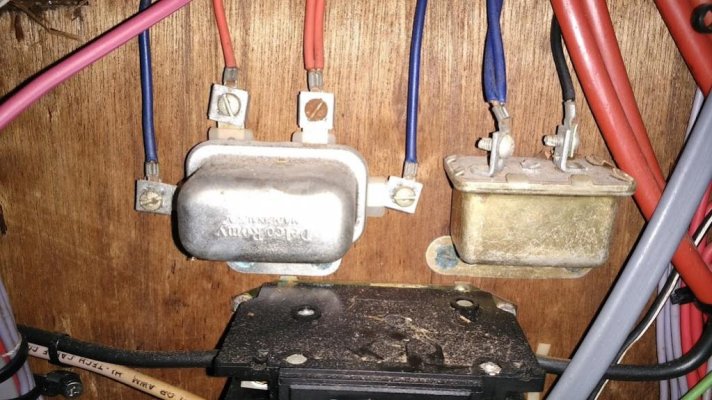Hello - first post here - Im working on the above mentioned boat, and the owner wants to put oil pressure and water temp alarms on the upper helm (am amazed these arent standard). Plan was to wire a 12v buzzer in parallel to the one on the down helm station, but that doesnt seem to want to work.. plus there are 4 connections to the oil pressure buzzer..
Its a Delco Remy (see attached photo). Anyone provide details on what the 4 connections might be?
Thanks in advance
Captain Dave aboard Sugar Too
New Bern, NC
Assuming this boat has analog oil pressure and temp guages and if the boat has a modern an NMEA 2000 MFD that has the capability to display mock guagues, another option is a "black box" made by NoLand Engineering, about $200. The wiring is quite simple, 12v power, ground wire, and a signal wire from the back of the guage. A NMEA 2000 drop wire goes from the black box to the backbone.
The black box must be programmed with a laptop and a utility supplied by the company. The programming is also simple. Using a thermomter shoot the temp of the engine at dead cold temperature, that is, after it has sat unstarted for as long as is necessary for the engine to cool to the same temp as the ambient temp. For each gauge (temp and oil pressure, two engines) the utility will show the voltage of the senders. At those voltages, the programmers then enters the engine temperature (cold) and "zero" for the oil pressure.
Then the engine is started and run up to dock idling temperature which should be a stable value. Next to the voltage value for engine temp, the programmer enters the actual engine temp. Here one has some choices. Most folks would prefer to have the MFD "guage" read the same value as the analog guage. However, the accuracy of old analog guages may be suspect and one has to interpolate from the needle position. On our boat (1983 Defever), I replaced the analog guages with Intellitronix digital gauges with new senders. They have a numerical display so no interpolation and I belive the accuracy is likely to be much higher than those 30-year-old analogs. Or, using the infrared thermometer, one could shoot the actual engine temp and use that number. However, this method has its own inherent problems, that is, where does one actually shoot on the engine to get the "real" operating temp. In any case, get a temp, enter it into the programming utility.
By this time you have figured out how one enters the value for the oil pressure. Read your analog guage and I suppose if one is really a stickler for accuracy, one could temporarily thread in a mechanical oil pressure guage and read the oil pressure directly at the engine. This same black box has the ability to set an alarm threshold for both engine temp and oil pressure, user specified. Being able to specify one's own alarm may be of value to those who would feel more comfortable with a "lower than stock" alarm temp.
Now here's another benefit of this product. It can also display a tachometer, two if you have two engines. One just runs a signal wire from a source. The alternator can be used but we all know how tempermental this can be for a tach input. A better source would be a signal generator of some manufacture. For example, one could use a mechanical sender made by Aetna Engineering. Many engines have a port into which a sender can be screwed. On Lehman 120's, the port is very accesible. If your engines, as mine do, uses that port for the cable that runs to the Gledinning synchronizer box, know that that box has auxiliary ports that are there for just that purpose. So, for those who are constantly driven crazy with the inconsistency of alternator driven tachometers, this presents an elegant and quite simple solution and not to mention high accuracy. The Aetna sender produces eight pulses per revolution. This value is entered, done. Total cost, including the tach senders is about $450.
The black box also has the ability to display voltage and amperage although the amp feature requires a shunt and another electronic interface gizmo which costs about $50.
The programmer then enters

